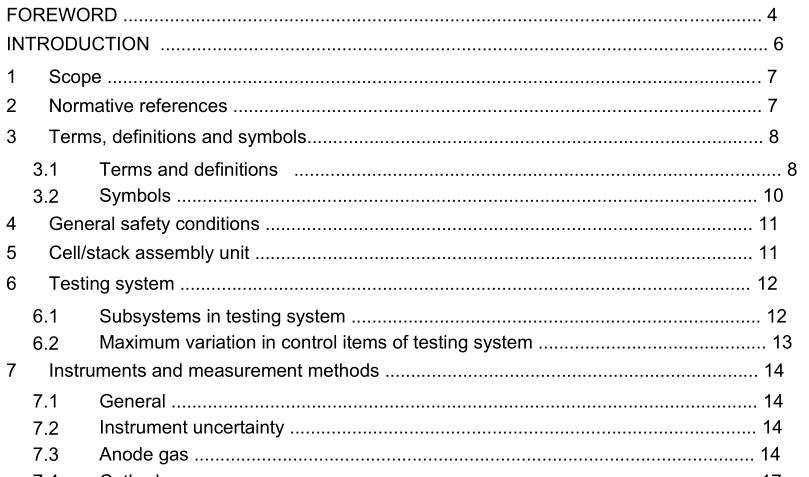IEC 62282-7-2-2021 pdf Fuel cell technologies – Part 7-2: Test methods – Single cell and stack performance tests for solid oxide fuel cells (SOFCs)

3.1.7 cathode gas gas that is supplied to the inlet of the cathode of a single cell/stack assembly unit Note 1 to entry: Oxygen and nitrogen are its main components. 3.1.8 current collector conductive material in a fuel cell that collects electrons from the anode side or conducts electrons to the cathode side 3.1.9 stable state condition of a cell/stack assembly unit at which the unit is stable enough for any controlling parameter and the output voltage or output current of the unit to remain within its tolerance range of variation 3.1.10 theoretical current current when the supplied anode gas or cathode gas is completely consumed in electrochemical reactions divided by the number of cells in a series connection 3.1.11 effective fuel utilization ratio of the actual output current of the cell/stack assembly unit to the theoretical current Note 1 to entry: The effective utilization is the utilization of reactants in the electrochemical reaction due to the actual current. This may be less than the actual or total utilization if there are gas inlet and cross leaks. Note 2 to entry: Causes of less-than-optimal currents include losses due to electronic conduction within the cell/stack assembly, gas leaks and anode gas pass-through. Note 3 to entry: A calculation method of effective fuel utilization is given in Annex B. 3.1.12 effective oxygen utilization ratio of the actual output current of the cell/stack assembly unit to the theoretical current Note 1 to entry: The effective utilization is the utilization of reactants in the electrochemical reaction due to the actual current. This may be less than the actual or total utilization if there are gas inlet and cross leaks. Note 2 to entry: A calculation method of effective oxygen utilization is given in Annex C. 3.1.13 maximum effective fuel utilization highest effective fuel utilization that the unit can operate at, without causing unacceptable degradation
- Previous:IEC 62372-2021 pdf Nuclear instrumentation – Housed scintillators – Test methods of light output and intrinsic resolution
- Next:IEC 62148-21-2021 pdf Fibre optic active components and devices – Package and interface standards – Part 21: Design guidelines of electrical interface of PIC packages using silicon fine-pitch ball grid array (S-FBGA) and silicon fine-pitch land grid array (S‑FLGA)
- ISO IEC 27050-4-2021 pdf Information technology — Electronic discovery — Part 4: Technical readiness
- ISO IEC 27036-1-2021 pdf Cybersecurity — Supplier relationships — Part 1: Overview and concepts
- ISO IEC 27013-2021 pdf Information security, cybersecurity and privacy protection — Guidance on the integrated implementation of ISO/IEC 27001 and ISO/IEC 20000-1
- ISO IEC 26580-2021 pdf Software and systems engineering — Methods and tools for the feature- based approach to software and systems product line engineering
- ISO IEC 24735-2021 pdf Information technology — Office equipment — Method for measuring digital copying productivity
- ISO IEC 24711-2021 pdf Information technology — Office equipment — Method for the determination of ink cartridge yield for colour inkjet printers and multi- function devices that contain printer components
- ISO IEC 23544-2021 pdf Information Technology — Data centres — Application Platform Energy Effectiveness (APEE)
- ISO IEC 23510-2021 pdf Information technology — 3D printing and scanning — Framework for an Additive Manufacturing Service Platform (AMSP)
- ISO IEC 23127-1-2021 pdf Information technology — Learning, education, and training — Metadata for facilitators of online learning — Part 1: Framework
- ISO IEC 23126-2021 pdf Information technology for learning, education and training — Ubiquitous learning resource organization and description framework
- IEC 60034-9-2021 pdf Rotating electrical machines – Part 9: Noise limits
- IEC 62769-6-2021 pdf Field device integration (FDI) – Part 6: Technology Mapping
- IEC 62282-7-2-2021 pdf Fuel cell technologies – Part 7-2: Test methods – Single cell and stack performance tests for solid oxide fuel cells (SOFCs)
- ISO IEC 7816-8-2021 pdf Identification cards — Integrated circuit cards — Part 8: Commands and mechanisms for security operations
- IEC 60974-11-2021 pdf Arc welding equipment – Part 11: Electrode holders
- BS ISO IEC 15420-2009 pdf Information technology一 Automatic identification and data capture techniques EAN/UPC bar code symbology specification
- BS ISO IEC 19762.5-2008 pdf Information technology一 Automatic identification and data capture (AIDC) techniques – Harmonized vocabulary Part 5: Locating systems
- BS IEC 60860-2014 pdf Radiation protection instrumentation一 Warning equipment for criticality accidents
- ISO IEC 24735-2021 pdf Information technology — Office equipment — Method for measuring digital copying productivity
- ISO IEC 24711-2021 pdf Information technology — Office equipment — Method for the determination of ink cartridge yield for colour inkjet printers and multi- function devices that contain printer components